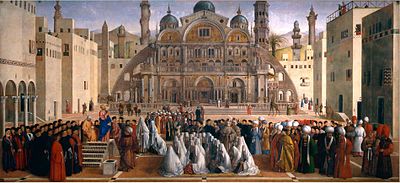Giovanni Bellini
His paintings from the early period are all executed in the old tempera method: the scene is softened by a new and beautiful effect of romantic sunrise colour (as, for example, in the St. Jerome in the Desert).
In 1470 Giovanni received his first appointment to work along with his elder brother, Gentile, and other artists in the Scuola di San Marco, where among other subjects he was commissioned to paint a Deluge with Noah's Ark.
The still more famous altarpiece painted in tempera for a chapel in the church of S. Giovanni e Paolo, where it perished along with Titian's Peter Martyr and Tintoretto's Crucifixion in the disastrous fire of 1867.
The importance of this commission can be measured by the payment Giovanni received: he was awarded, first the reversion of a broker's place in the Fondaco dei Tedeschi, and afterwards, as a substitute, a fixed annual pension of eighty ducats.
These works, executed with much interruption and delay, were the object of universal admiration while they lasted, but not a trace of them survived the fire of 1577; neither have any other examples of his historical and processional compositions come down, enabling us to compare his manner in such subjects with that of his brother Gentile.
The enthroned Virgin and Child (such as the one at left) become tranquil and commanding in their sweetness; the personages of the attendant saints gain in power, presence and individuality; enchanting groups of singing and viol-playing angels symbolize and complete the harmony of the scene.
Already in the years 1501–1504 the marchioness Isabella Gonzaga of Mantua had experienced great difficulty in obtaining delivery from him of a painting of the Madonna and Saints (now lost) for which part payment had been made in advance.
Albrecht Dürer, visiting Venice for a second time in 1506, describes Giovanni Bellini as still the best painter in the city, and as full of all courtesy and generosity toward foreign brethren of the brush.
He lived to see his own school far outshine that of his rivals, the Vivarini of Murano; he embodied, with growing and maturing power, all the devotional gravity and much also of the worldly splendour of the Venice of his time; and he saw his influence propagated by a host of pupils, two of whom at least, Giorgione and Titian, equalled or even surpassed their master.
Other pupils of the Bellini studio included Girolamo Galizzi da Santacroce, Vittore Belliniano, Rocco Marconi, Andrea Previtali[11] and possibly Bernardino Licinio.
Significantly influenced by Antonello da Messina and contemporary trends such as oil painting, Bellini introduced the pala, or single-panel altarpieces, to Venetian society with his work Coronation of the Virgin.
He blends this new technique with Venetian and Byzantine traditions (previously influencing art in the city) of iconography and colour to create a spiritual theme not found in Antonello's pieces.
The realism of oil painting coupled with the religious traditions of Venice were unique elements to Bellini's style, which set him apart as one of the most innovative painters in the Venetian Renaissance.
In 1822, German artist and composer Therese Emilie Henriette Winkel copied Bellini's work Christ Blessing for an altarpiece for the Brockwitz church in Dresden, Germany, which is still preserved today.







